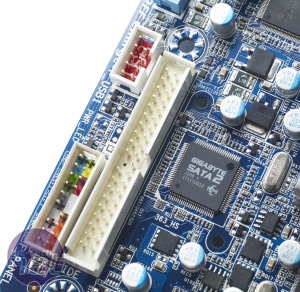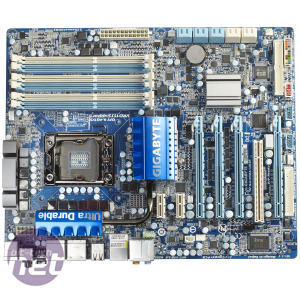Performance Analysis
We were desperate to see if we had another classic on our hands, so we subjected the UD3R (rev 2) to our battery of motherboard tests. We should mention at this point that we were testing with the newly released FB16 beta BIOS that was released on Gigabyte's website on 8 of August.The UD3R (rev 2) started in a fairly average fashion in our storage tests, as the ICH10R-fed SATA 3Gbps ports returned a read speed of 238MB/sec and a write speed of 213MB/sec. This is slower than the first UD3R, but not by much. The SATA 3Gbps ports powered by the custom Gigabyte chip on the other hand returned an abysmal speed of 127MB/sec read and 126MB/sec write. It’s great that Gigabyte has loaded the UD3R with SATA ports, but the two ports controlled by the Gigabyte chip are barely worth using for anything other than optical drives.
The SATA 6Gbps ports on the board hit speeds of 214MB/sec write and 290MB/sec read. This isn’t as quick as the HighPoint Rocket R620 PCI-E card we’ve been using for SSD testing recently, but are still an improvement over SATA 3Gpbs speeds.
Matters improved for the UD3R (rev 2) when it scored a solid overall score of 2,106 in our Media Benchmarks (at stock speed), which is actually slightly higher than the first revision of the UD3R, which scored 2,100. In fact this score put the UD3R (rev 2) at the top of the stock speed table of X58 motherboards, which is no mean feat for such a keenly priced board. It should be noted though that only 30 points separate the top six X58 boards we’ve seen, which is a margin of only 0.1 per cent.
The results in our Crysis tests at stock speeds were slightly less than we had hoped for, as the UD3R (rev 2) only managed a minimum framerate of 31fps and an average of 54fps. This puts it towards the bottom of the X58 boards we've tested and is significantly behind gaming-orientated boards such as the excellent Asus Rampage III Gene.
Overclocking
The jewel in the original UD3R’s crown was its overclockability, however, so we were eager to see how the revised board would fare in comparison. To find out we set about first testing the board for its maximum stable QPI frequency. With the multiplier of our test CPU dialled down to 12x a good board should be able to manage a QPI of 220MHz, which seems to be the air-cooled limit of the X58 chipset. Thankfully the UD3R (rev 2) easily managed this, meaning we could move on to seeing how well it overclocked.After a touch of tinkering we managed to get our CPU up to its maximum air-cooled speed of 4.4GHz, which improved the UD3R (rev 2)’s performance markedly. In the image editing portion of our Media Benchmarks the board scored a healthy 1,873 which was second only to the Rampage III Gene. The UD3R (rev 2) continued this trend of great performance in our video encoding test and the 4,131 points the board scored was the highest result we’ve seen. Things didn’t go so well for the UD3R (rev 2) in our demanding multi-tasking test, but its final overall score of 2,550 is a solid, if unspectacular result.
The UD3R (rev 2)’s performance in Crysis saw a marked improvement with our overclock applied, with the board jumping from the bottom of the table to within 2fps of the chart-topping Rampage III Gene.
Conclusion
We’re happy to say that the UD3R (rev 2) lived up to our expectations after we'd applied the latest BIOS. The board proved to be quick at stock speeds and eminently overclockable; when combined with its keen price these factors make the board extremely attractive.The only fly in the ointment is the Asus P6X58D-E which we’ll be reviewing tomorrow, as it’s very closely matched to the Gigabyte board both in price and performance. The Gigabyte board does have one or two advantages over the Asus board though, such as its IDE port (which the P6X58D-E lacks), the veritable feast of SATA ports (even if two are terribly slow) and the extra PCI-E 16x slot.
If any of these are important to you then the UD3R (rev 2) shades it over the P6X58D-E. If on the other hand they aren’t then it’s worth checking back tomorrow for our write up of the P6X58D-E. Either way, it can’t be denied that the UD3R (rev 2) is an excellent basis for LGA1366 build: it’s cheap, overclockable, quick and well specced. We think that's worth an award, don’t you?
- Performance
- x
- x
- x
- x
- x
- x
- x
- x
- x
- -
- 9/10
- Features
- x
- x
- x
- x
- x
- x
- x
- x
- -
- -
- 8/10
- Value
- x
- x
- x
- x
- x
- x
- x
- x
- x
- -
- 9/10
- Overall
- x
- x
- x
- x
- x
- x
- x
- x
- x
- -
- 9/10

Gigabyte GA-X58A-UD3R

MSI MPG Velox 100R Chassis Review
October 14 2021 | 15:04













Want to comment? Please log in.